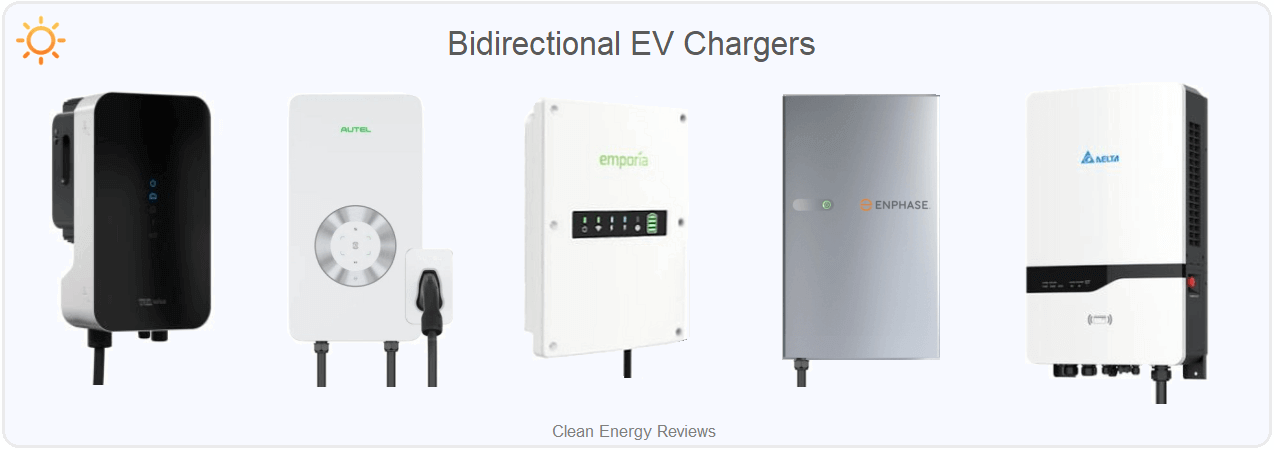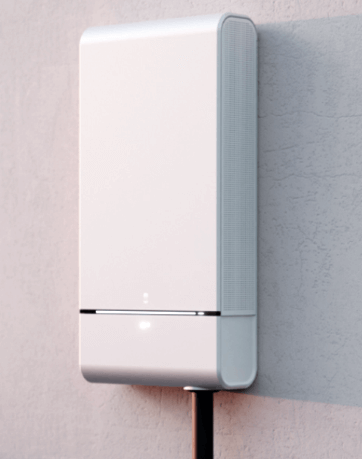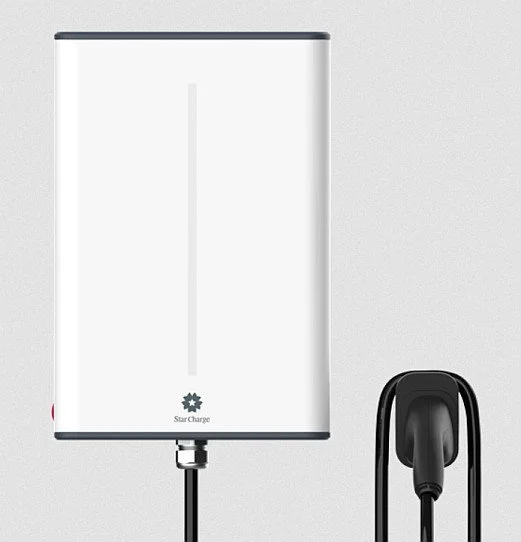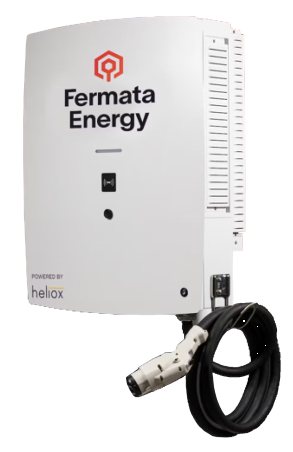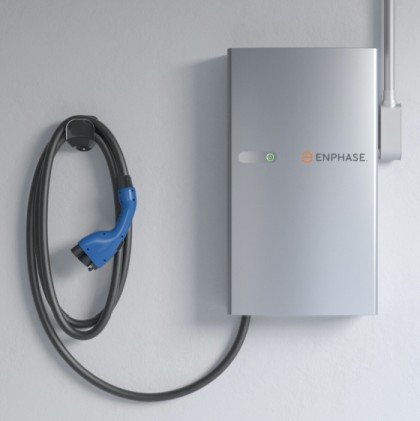Bidirectional EV Chargers Review - V2G & V2H
What is a bidirectional EV charger?
A bidirectional EV charger is an advanced EV charging system that enables two-way energy transfer, allowing electric vehicles (EVs) to send power to your home or back into the electricity grid. Unlike standard EV chargers, which use regular AC (alternating current) power for charging, bidirectional chargers perform complex power conversion, converting power from AC to high-voltage DC (direct current) during charging and the reverse during discharging.
Bidirectional EV charging is an exciting and emerging technology with the potential to revolutionise how electricity is generated and distributed, enhancing grid stability and offering cost-saving and backup power for homeowners. However, due to complex electrical regulations, bidirectional EV chargers are generally only available under special agreements or trials with grid operators in most countries.
Basic energy conversion diagram of a DC bidirectional EV charger.
What are bidirectional EV chargers used for?
Bidirectional EV chargers have two primary uses:
Vehicle-to-Grid (V2G)
A bidirectional charger enables Vehicle-to-Grid (V2G) functionality, allowing EVs to feed energy back into the grid during times of high electricity demand, such as the peak evening period. This concept is a form of decentralised energy generation that can transform the operation of our power grids. Learn more about vehicle-to-grid (V2G) here.
Vehicle-to-Home (V2H)
The second use of bidirectional chargers is for Vehicle-to-Home, allowing homeowners to use an EV to power their home. Using stored energy in the EV during peak times when electricity rates are higher, homeowners can reduce their energy costs and optimise renewable energy sources like solar power. Bidirectional chargers can also provide backup power sources during power outages, ensuring an uninterrupted electricity supply in emergencies. Learn more in our V2L, V2H & V2G explained article.
Issues with Bidirectional EV charger standards
While bidirectional EV charging is a new and exciting technology, progress has been slow, and most governments have not certified bidirectional chargers due to grid compliance and regulatory issues. Vehicle-to-grid (V2G) standards are challenging and complex, as they regulate power, safety, and electrical requirements when discharging energy into the grid. In North America, UL9741 is a proposed standard applicable to bidirectional EV charging system equipment, built around the UL1741 (safety standard) and the IEEE1547 standard for interconnecting distributed energy resources (DER) with electrical power systems.
The latest international standard for communication between an EV and a bidirectional charger is ISO 15118-20, which specifies a Vehicle-to-Grid Communication Interface. The purpose of this standard is to detail the communication between an EV (BEV or PHEV) and the EVSE (Electric Vehicle Supply Equipment), more commonly known as an EV charger.
V2G approved in Australia, almost!
Recent regulatory changes in Australia and New Zealand now permit bidirectional charging systems, such as solar or hybrid inverters, to be installed and connected to the grid. The Australian standards AS4777.1 and AS4777.2 now govern the installation and performance of inverters, including bidirectional chargers. The updated AS4777.1 was published in Q3 2024, and the revised AS4777.2 is expected by the end of the year. The Australian energy regulator aims to approve bidirectional charging (vehicle-to-grid) by year-end. This will likely lead to updates in the AS/NZS3000 wiring rules to incorporate this technology as part of inverter systems.
List of Bidirectional EV chargers
Currently, the Wallbox Quasar and Fermata FE-15 are the only bidirectional chargers suitable for home use that are compatible with the older CHAdeMO (DC) connector, whereas the recently released Sigenergy Sigenstor and Ambibox are compatible with the more common CCS (DC) vehicle charge port. The Ford F-150 Lightning EV is unique as the V2H will only function with the Ford Charge Station Pro (built on the Delta charger) and requires additional equipment to enable bidirectional charging.
In the past, Tesla's senior officials hinted at integrating bidirectional charging in their upcoming vehicles by 2025. However, there's no official confirmation yet on when Tesla will adopt V2G/V2H technology. However, two innovative EU companies, InterControl and Ambibox, in Germany, successfully conducted a V2H test with a Tesla Model Y and Model 3 using a bidirectional charger without any vehicle modifications. This discovery transformed our understanding of Tesla's true V2H and V2G capabilities. It was rumoured that Tesla was holding back on enabling bidirectional functionality to ensure home battery sales were not impacted before official V2G regulations and standards were in place.
Bidirectional V2G &V2H Chargers Summary Table
| Charger | Power Output | Bidirectional Modes | Connector | Type | Notes |
|---|---|---|---|---|---|
| Sigenergy SigenStor | 12.5 kW / 25 kW | V2H (V2G pending) | CCS | Hybrid System | Most affordable per kW; requires full SigenStor system, US$4,000–7,000 |
| Wallbox Quasar | 7.4 kW | V2G, V2H | CHAdeMO | Standalone | CHAdeMO only; Nissan Leaf compatible, US$6,000 |
| Wallbox Quasar 2 | 11.5 kW | V2G, V2H | Expected CCS | Standalone | Redesigned, blackout mode; pricing TBC |
| Ambibox DC Wallbox | 11 kW / 22 kW | V2G, V2H | CCS / CHAdeMO | Standalone | Advanced comms; wide compatibility |
| StarCharge Halo | 7.4 kW / 11 kW | V2G | CCS | Standalone | Advanced comms; Australian Approval, Pricing TBC |
| Rectifier Highbury | 7 kW / 11 kW | V2G, V2H (future) | CCS / CHAdeMO | Standalone | Slim design; release & pricing TBC |
| Emporia V2X | 11.5 kW | V2G, V2H | CCS | Standalone | Est. US$2,500; off-grid capable; in design phase |
| Fermata FE-20 | 20 kW | V2G | CCS | Commercial | UL 9741 certified; Nissan Leaf only |
| Delta V2H | 11 kW / 22 kW | V2H | CCS / CHAdeMO | Standalone | 95% efficient; est. US$10k–12k |
| Autel MaxiCharger V2X | 12 kW | V2G, V2H | CCS / CHAdeMO | Standalone | 150–950V range; release & pricing TBC |
| Enphase Bidirectional | ~6 kW (est.) | V2G, V2H | CCS | Hybrid System | IQ8-based; launch delayed to 2026 |
| SolarEdge Charger | 12 kW / 24 kW | V2G, V2H | CCS | Hybrid System | DC-coupled; 2026 launch; est. US$12k–15k |
| Ford Charge Station Pro | 19.2 kW (9.6 kW V2H) | V2H | CCS | Hybrid System | Needs Delta DBI & integration kit; ~US$12k–15k |
| GM PowerShift Charger | 19.2 kW | V2H | CCS | Hybrid System | Home Hub + 10.6 kWh battery bundle ~US$12,700 |
Sigenergy SigenStor
Sigenergy SigenStor hybrid system including DC bidirectional EV charger.
The Sigenergy SigenStor is one of the most exciting products enabling bidirectional EV charging. Unlike the other dedicated bidirectional DC chargers, Sigenergy has developed a versatile and modular hybrid system that integrates solar, battery storage and bidirectional EV charging into one unit. The system comprises four main components: a hybrid inverter, battery modules, a backup box (gateway), and an optional bidirectional EV charger.
On the EV charging side, the DC bidirectional charger will be available in two sizes: a smaller 12.5kW unit or a large 25kW unit designed to be used with a 3-phase AC supply. However, the true innovation lies in the DC power bus, which enables direct DC charging from solar. Additionally, the battery-integrated DC-DC conversion boosts the relatively low voltage of the battery modules to 150V—1000V, matching the various EV battery voltages. Using the additional Gateway backup box, the system can operate in off-grid mode and provide true UPS (Uninterruptible Power Supply) power.
Pricing - Now available in Australia
The Sigenergy system was first released in Europe and is now available for sale in Australia. Pricing is very competitive, with the smaller charger selling for around AU$6,000 or US$4,000, while the larger 25kW bidirectional DC charging unit goes for AU$7,000 (US$5,000), making these the most affordable bidirectional chargers (per kW) available (assuming you have a Sigenergy system). Note that the bidirectional charging unit cannot be used for V2G unless given regulatory approval in your area. However, the system can already be used in off-grid or Vehicle-to-Home (V2H) mode, which effectively isolates your home from the grid and utilises the vehicle battery to power your home.
Download the Sigenergy Sigenstor datasheet or the bidirectional charger specifications.
Wallbox Quasar
Wallbox Quasar two-way DC charger
The Wallbox Quasar is the first bidirectional EV charger designed for home use and is the smallest charger of its kind to offer advanced two-way DC charging capabilities. It has a maximum power rating of 7.4kW (32A), but it’s important to note it is only compatible with vehicles that feature a CHAdeMO DC vehicle connector. Currently, only the later generation Nissan Leaf EV and Mitsubishi Outlander plug-in hybrid can be used with the Wallbox Quaser.
As explained earlier, bidirectional chargers can enable V2G or V2H but it is early days for this emerging technology, so some investigation will be required to ensure it can be utilised in your state or region. Additionally, some electricity retailers and regulators may not have approved using bidirectional EV charging. In Australia, regulatory approvals for bi-directional chargers are about to be ratified, along with several V2G trials already underway.
The Quasar is priced from US$4000 to $7000, depending on the country and local taxes.
Download the full Wallbox Quasar datasheet.
Wallbox Quasar 2
Wallbox Quasar 2 with backup mode
Wallbox recently announced the second generation Quasar 2. The new bidirectional DC charger has been redesigned from the ground up and now offers up to 11.5kW (48A) of charging or discharging power. The styling has also completely changed from the previous model, which was rather unconventional, to a slick-looking slimline enclosure with no display. More importantly, the new Quasar 2 features a “blackout mode”, allowing a compatible vehicle to power your home in the event of a power outage. Wallbox claims it will be able to transition your home from grid supply to vehicle supply seamlessly; this implies that it works in conjunction with an external grid isolator (contactor), which is required to safely island your home from the grid. The full specifications have not yet been released, although the company website outlines that it will contain a vast array of communication options, including WiFi, Ethernet, Bluetooth and even 3G/4G.
Official pricing is not yet available for the Wallbox Quasar 2, but it is expected to range from $5000 to $7500.
Ambibox DC Wallbox
Ambibox is a German company specialising in advanced power electronics with a focus on developing cutting-edge technologies to enhance the efficiency and reliability of energy conversion systems. Their expertise includes designing and manufacturing high-performance inverters, smart energy management systems, and bidirectional charging solutions.
Ambibox's most advanced product, the DC Wallbox Bidirectional Charger, is available in 11kW and 22kW three-phase varieties. The chargers support two-way DC energy transfer up to 400V, allowing bidirectional capabilities, including V2G and V2H. Additional features include compatibility with OCPP 2.0.1 & 1.6J, Websockets, MQTT, and SmartHome protocols, allowing for a wide range of connectivity.
The Ambibox team used the DC wallbox to enable V2H using a BYD Atto 3, KIA EV9 and numerous other popular EVs in a test environment. Both the BYD and KIA vehicles are only certified for use with V2L using an adapter and are not officially capable of bidirectional DC charging. The company also successfully conducted a V2H test with a Tesla Model Y and 3. This exciting revelation suggests many EVs may already have V2G capability built-in and may only require a software update or a compatible bidirectional charger to utilise.
In late 2024, Australian energy storage manufacturer RedEarth Energy Storage announced an official partnership with Ambibox to produce vehicle-to-grid bidirectional EV chargers for the Australian and New Zealand markets. The chargers will be manufactured by RedEarth in Queensland. While pricing has not yet been released, the three-phase V2G charger is expected to be available for installation in Australia by June 2025, followed by the single-phase version later in late 2025.
Download the Ambibox DC Wallbox datasheet.
StarCharge Halo
StarCharge, established in 2014, is a global leader in EV charging infrastructure and microgrid technologies, with over 2 million EV charging points installed worldwide. The company has rapidly expanded across international markets and is now recognised as one of the largest EV charger manufacturers by cumulative global sales.
The Halo is StarCharge’s flagship bidirectional DC charger, available in 7.4kW (single-phase) and 11kW models. Designed primarily for Vehicle-to-Grid (V2G) applications, the Halo offers up to 97% peak efficiency and supports the latest EV communication standards, including ISO 15118-2 and 15118-20. Connectivity features include WiFi, 4G, and Bluetooth, enabling integration with smart energy management platforms and future V2X capabilities.
In the Australian market, the Halo has completed over two years of local development and testing, receiving approval from multiple distribution network service providers (DNSPs). It is also in the final stage of certification under AS 4777.2, the key Australian standard for inverter-connected energy systems. However, it remains unclear whether the Halo supports Vehicle-to-Home (V2H) functionality for backup power and what additional hardware is required for off-grid operation.
Pricing is not yet available
Download the StarCharge Halo datasheet.
Rectifier Technologies Highbury
Australian power conversion equipment manufacturer Rectifier Technologies is the second company to develop a compact residential two-way charger. The Highbury bidirectional DC charger, available soon, claims to be 96% efficient and features a very modern, slim design. The Highbury, touted as the world’s slimmest bi-directional DC charger, will be available in two sizes, the standard 7kW and a high power 11kW (46A).
Initially, it will enable EV owners to sell excess power to the grid via V2G, but additional functionality, including vehicle-to-home (V2H), will be available later. The Highbury will be compatible with both CHAdeMO or CCS-compliant electric vehicles.
Download the Highbury bidirectional charger datasheet.
Pricing is not yet available for the Highbury charger.
Emporia V2X bi-directional charger
The V2X is a home bidirectional charger from the small Colorado-based company Emporia, which specialises in smart home energy management products. The Emporia bidirectional charger is impressive and features an integrated silicon-carbide-based AC/DC inverter designed by BREK Electronics, rated at a maximum of 48A or 11.52kW. It's compatible with CSS Type 1 connectors and can be coupled with the Emporia Vue home energy management system to automate your energy use and storage needs. More notably, it also features 'off-grid islanding support', which implies it will function in off-grid mode by adding a compatible grid isolation device (contactor).
The price was listed at US$2,500, making this one of the most affordable universal bi-directional chargers. However, this price has not been verified, and the product is still in the design phase. It is expected to be released sometime in late 2025.
Download the Emporia V2X bidirectional charger datasheet.
Fermata Energy FE-20
Fermata Energy is a US-based company founded in 2010 by Prof. Slutzky, a science and engineering professor at the University of Virginia. The FE-20 is the next-generation bidirectional charger after the FE-15, and is currently the most powerful two-way DC charger available in North America, with a 20kW charge and discharge power rating. However, the charger is currently only compatible with vehicles with a CHAdeMO DC connector. Based on the aesthetics and specifications, the wall-mounted charger is designed for performance, durability, and safety.
The FE-20 bidirectional charger is UL 9741 certified and is currently the only DC charger certified for use with the Nissan LEAF in the US. Fermata Energy has also developed a more powerful 3-phase 20kW bidirectional charger for use with small commercial electric vehicles.
The full Fermata Energy FE-20 bidirectional charger specifications and pricing is not yet available.
Delta V2H bidirectional charger
Delta Electronics is a large, innovative company specialising in energy efficiency and power conversion equipment, including solar and energy storage. With a long history in designing and building EV chargers and huge research and development capabilities, it’s not surprising that Delta has produced a range of bidirectional EV chargers for commercial and residential applications.
The Delta V2H is a 3-phase vehicle-to-home (V2H) bidirectional charger in two models rated at 11kW or 22kW. The charger can operate in on-grid and off-grid (backup) modes, but is currently only compatible with CHAdeMO vehicle connectors. It features a very high operating efficiency of 95%, along with a range of safety systems. A smaller 6kW single-phase version is also in development, but details are limited at this stage. Pricing has not been confirmed but is expected to be in the range of $10,000 to $12,000 for the 11kW model.
Download the full Delta V2H bidirectional charger specifications.
Autel MaxiCharger V2X
Autel Energy is a US-based company established in 2004 that specialises in intelligent automotive products and services. Over recent years, the company developed high-quality home EV chargers, a range of fast DC chargers, and commercial EV charging solutions.
The MaxiCharger V2X from Autel is a high-power 12kW bidirectional charger that offers both V2G and V2H functions, or vehicle-to-everything, hence the term V2X. It will be available with either CCS1 or CHAdeMO and offers a full range of communication options, including Bluetooth, WiFi, ethernet, CAN and RS485, along with the OCPP 1.6J communication protocol. More notably, the CCS1 version operates with a wide DC voltage range from 150 to 950V DC, meaning it will be compatible with the newer high-voltage (800V) vehicle platforms.
The official release date and pricing are unknown.
Enphase bidirectional EV charger
Enphase bidirectional EV charger
Enphase Energy was founded in 2006 and is the world’s leading manufacturer of solar microinverters. The Enphase bidirectional EV charger is unique because it's built around the IQ8 microinverter technology, enabling both V2G and V2H functionality. The IQ8 microinverters are micro-bidirectional inverters that can operate in on-grid and off-grid modes. Hence, they are an ideal foundation for building a bidirectional charger and enabling seamless integration into the Enphase home energy ecosystem. The bidirectional charger is very similar to the Enphase Encharge battery system, but in the case of the EV charger, the battery is inside the vehicle. Learn more about the Enphase battery and bidirectional charger in our detailed Enphase Review.
Enphase has not released the full specifications, so the exact details remain unknown. Based on the limited information provided and the assumption that it is similar to the Encharge 10 battery system, it is estimated that the power rating will be relatively modest at around 6kW. Enphase has released an excellent white paper explaining the various features and bidirectional functions. Due to regulatory delays and technical challenges, the release date of the Enphase charger has now been pushed out to 2026.
SolarEdge bidirectional EV charger
SolarEdge Technologies is a well-known solar company that manufactures solar inverters for residential and commercial applications. Founded in 2006, SolarEdge is unique among inverter suppliers as they do not manufacture conventional string solar inverters but what the company refers to as intelligent inverter systems using panel-mounted DC power optimisers.
The SolarEdge bidirectional charger is a unique DC-coupled EV charger that integrates with the SolarEdge ecosystem built around a high-voltage DC bus (interconnection). Many modern home battery systems use a DC-coupled HV battery and a bidirectional (hybrid) inverter. Building on this, SolarEdge made a clever move by integrating an EV charger using the bidirectional capability of its solar inverters. The EV charger itself will be the part that connects to the vehicle and manages the charging.
SolarEdge has not yet released the full details, but based on the information provided, the charger has a charge rate of 12 kW and a maximum discharge rate of 24 kW. Using a standard CSS connector, it will be compatible with 400V and 800V EV powertrains. The charger will provide vehicle-to-home (V2H) and vehicle-to-grid (V2G) capability. The SolarEdge bidirectional charger's release is now expected in 2026. Based on the specifications, pricing would be at the higher end of the scale, ranging from $ 12,000 to $ 15,000.
Ford Charge Station Pro
The Charge Station Pro is a Ford exclusive EV charger rated at a maximum of 80-Amps, or 19.2kW (240V), which was released along with the new Ford F-150 Lightning Electric Pickup in mid-2022. The charger was developed in collaboration with Siemens eMobility. It will allow the F-150 EV to power a home, providing up to 9.6kW of power when installed with the Home Integration System to enable what Ford has dubbed intelligent backup power.
However, the Ford Charge Station Pro only functions as a bidirectional charger when combined with Ford’s home integration system, which consists of a 10kW bidirectional charger, monitoring equipment, energy meters and a transfer switch to enable islanding (grid isolation) during a blackout.
The home integration system currently offered by Sunrun in collaboration with Ford contains a 10kW Delta Bidirectional charger (DBI) similar to the unit listed previously. The Delta DBI operates similarly to a high-voltage hybrid solar inverter, combining a high-voltage battery input with four solar trackers (MPPT inputs) to enable direct DC charging from solar sources. Additional equipment is required for whole-home backup, as displayed in the diagram below.
The official price of the Ford Charge Station Pro is US$1310 plus installation. Pricing for the Ford Home integration (Delta DBI and associated backup equipment) is approximately $ 12,000 to $ 15,000 for the complete system.
Download the Ford Charge Station Pro datasheet.
The Ford Home Integration system includes the Delta 10kW bidirectional charger - Image credit Sunrun
GM Energy Powershift Charger
The GM Energy PowerShift Charger and V2H Enablement Kit is GM’s custom solution to provide vehicle-to-home (V2H) bidirectional charging using a compatible GM electric vehicle. The Charger itself can be used for EV charging with up to 19.2kW (80-amp) output and features smart scheduling to take advantage of off-peak prices.
To provide bidirectional power flow and tap into the EV energy as a source of backup power, the GM V2H Enablement Kit bundle is required. The Kit consists of a Home Hub, a 9.6kW inverter and a small ‘dark start’ battery, which is used to power the communications and connect to the vehicle if grid power is unavailable. The Home Hub is the brains of the system and contains communications, a 200A grid connection and an isolation (islanding) contactor, enabling off-grid operation. It also unlocks the full bidirectional capabilities of the GM Energy PowerShift Charger so you can send energy from a compatible GM EV to provide power to your home in a blackout.
Home Battery Storage
For home energy storage, GM offers the GM Energy Home System, which uses the GM Powerbank battery with the Home Hub & Inverter to store energy from the grid or solar for later use. GM Energy PowerBank is available in 3 storage capacities depending on user needs:
10.6kWh* Battery Capacity with 5kW Charge/Discharge Power
17.7kWh Battery Capacity with 7kW Charge/Discharge Power
35.4kWh* Battery Capacity (2 x 17.7kWh PowerBanks) with 9.6kW Charge/Discharge Power (off-grid mode)
How much does the GM V2H system cost?
The EV charger itself is US$1,699, while the V2H bundle, including the EV charger, 9.6kW inverter, black start battery and Home hub, is $7,299, excluding any state or government rebates. The Whole Home solution, including the V2H bundle and 10.6kWh home battery, comes in at $12,700, which is reasonable considering it consists of a home energy storage system that also unlocks the massive storage capacity of the EV battery. Note the prices do not include installation and local taxes.
The complete GM Energy Home V2H System installed with the modular home storage battery (left side)

